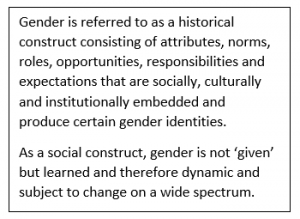Difference between revisions of "Gender First Aid Kit"
| Line 22: | Line 22: | ||
===Biological determinism as social theory=== | ===Biological determinism as social theory=== | ||
| + | |||
| + | ====Biological determinism and sex==== | ||
| + | |||
| + | ====Biological determinism and race==== | ||
===Exclusive science=== | ===Exclusive science=== | ||
Revision as of 16:19, 23 May 2022
Contents
- 1 Introduction
- 2 History of Gender
- 3 Gender Neutral Language
- 4 Pronouns
- 5 Talking Behaviour
- 6 Toilets
- 7 Institutional commitment
- 8 References
Introduction
This Wiki article aims at giving a first and basic introduction to the topic of gender. Our intention is to offer some helpful tools and advice on how gender is important to consider in everyday life at university. We hope that students and teachers find helpful information and suggestions of how to act more aware regarding gender.
As this is meant to be a gender first aid kit we start this article by offering some practical advice on how to use gender neutral language and different pronouns as well as reflect on one’s own talking behaviour. After that we will describe the history of the concept of gender and thereby highlighting to you the most important information on the topic from our point of view. In the end, we will point out the relation of institutions such as universities with gender and explain why it is one important factor to consider while studying or working in an institution.
Disclaimer: The contents of this article require a very sensitive use of language and certain words. We as authors reflected upon that and want to share our thoughts with you before reading. During this article we will refer to and write about BIPoC (Black, Indigenous and People of Colour). We decided to rather use the term non-white people as this is more descriptive, and BIPoC is often used as empowering self-designation, which is why we as only white authors do not want to claim that. Furthermore, we are aware of our own privileged position regarding gender identity, social and academic background.
History of Gender
This section will provide a brief historical outline of how the concept of sex, and later gender, came into being from the 18th century onward until today. This is by no means a complete historical account but rather tries to give an introduction to the topic. The further links we provide might be a good starting point to deepen your knowledge if interested. We will mainly focus on the Enlightenment period in which natural sciences such as anthropology and biology emerged to explain the development of the sex binary and the differentiation of humans in races. After that, there will be a short summary of the four waves of feminism focusing on each’s main claims and developments regarding sex and gender. Furthermore, this historical section refers to the German/European/Western history of sex and gender and cannot be generalized to other societies, cultures and regions of the world.
Disclaimer: We decided to use the historical terms and meanings for sex and gender as they were used at the given time. By that we do not wish to reproduce the biological differentiation into women and men as right gender understanding but to increase the comprehensibility for the reader and to display the understanding of sex and gender at the respected historical time. Trigger warning: Throughout this chapter, references to racism and colonialism are being made. There are never detailed descriptions of racist violence.
The Enlightenment
Society in the 18th century was widely built upon a hierarchical system rooted in gender and race, which constructed social positions based on gender and racial differences. This separation of society into women and men and white and non-white people emerged during the Enlightenment which was an intellectual movement in the 18th century that strived for objective answers based on reason.
All people are equal?
Thus, the previous focus of society on religion and culture was tried to be replaced by reason. Based on the idea that all people are equal by nature, social, civil and universal human rights slowly evolved. An early example of these developments were the demands of European women for more rights, thereby questioning long-established social arrangements with respect to women’s rights and duties. This is now considered the first wave of feminism. The demands of women at the time raised the question of whether and how such changes in rights would be justified. In addition, it was unclear whether males of different skin colour had equal property rights and, in the course of this, how slavery could be continued, since the system was depending on injust labour force. A supposedly ‘scientific’ answer rooted in reason on how to justify the continuation of social inequality was needed (Eagle Russett 1989, Schiebinger 1993). "They were looking to nature for solutions to questions about sexual and racial equality. [...] Scientists took up the task of uncovering differences imagined as natural to bodies and hence foundational to societies based on natural law. [They] did not draw their research priorities and conclusions from a quiet contemplation of nature, but from political currents of their times" (Schiebinger 1993; 9,183). Under the pretext of reason and building on what was believed to be modern science, biological sexism and racism emerged, paving the way to biological determinism.
